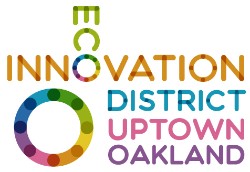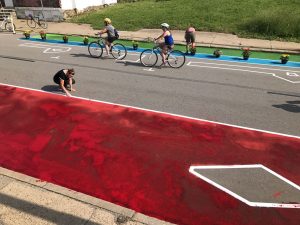EcoInnovation District

“The EcoDistricts approach is a new model of public-private partnership that emphasizes innovation and deployment of district-scale best practices to create the neighborhoods of the future – resilient, vibrant, resource efficient and just.”
Through a significant, first-ever financial investment, the City—with strong input from the community—contracted with a multi-disciplinary consultant team led by the Philadelphia firm Interface Studio to create one of the nation’s first EcoInnovation Districts.
The Uptown/West Oakland EcoInnovation District planning process officially kicked off in the Fall of 2015…. and for the following two years, Uptown Partners (UP), Oakland Planning and Development Corp., the City of Pittsburgh, Allegheny County, Sustainable Pittsburgh, Urban Redevelopment Authority, Port Authority of Allegheny County, and organizational change-makers worked closely with the Uptown community—including residents, institutions and businesses—in a unique public/private partnership to plan and implement the Uptown/West Oakland EcoInnovation District (EID).

A distinct equity focus sets this type of plan apart from traditional community plans. Equity is a lens by which all performance areas in the Plan are measured, such as health, wellbeing and safety, ability of residents to remain and thrive in our community, accessible mobility, public/open space, access to employment and entrepreneurial opportunities. EcoInnovation District goals are in alignment with the P4 Initiative (People, Planet, Place, and Performance) launched in 2015 to “create a new sustainable, innovative, and inclusive model for development and design.” To learn more visit P4 Initiative.
Uptown Partners (UP) played a key role, in collaboration with City Planning and Interface Studios, to ensure inclusive outreach and coordination of three public Open Houses, eight community meetings, 20 focus group meetings (of residents, businesses, developers, institutions and non-profits), and nine Steering Committee meetings. UP also helped generate 700 surveys to garner robust community feedback that drove the plan.
The EcoInnovation District Plan, some 244 pages, was adopted by the City in the fall of 2017, the first-ever comprehensive neighborhood plan officially embraced by the City, with a 10-year commitment to help shepherd the plan to fruition. When best practices are fully deployed, the District is intended to be a replicable testing ground for bold new measures, policies, strategies, and technologies that increase resiliency, find local and regional solutions to incentivize affordable housing through new zoning guidelines (see Uptown Public Real District), reduce energy usage and climate pollution through renewable and alternative energy sources, and foster an innovation economy.
The EID Plan is arranged into (4) four primary implementation areas:
1) Community: To Preserve and Strengthen the Existing Community
2) Development: To Encourage Balanced, Equitable, and Green Development
3) Mobility: To Provide Choice in Mobility
4) Infrastructure: To Invest in Sustainable Infrastructure
Click HERE to see the Uptown/West Oakland EcoInnovation District Plan.
The Uptown Task Force (UTF) is an overarching structure of organizations, residents, institutions, governmental and environmental leaders, service providers and others who are dedicated to ensuring successful outcomes of the EcoInnovation District Plan. The UTF is convened monthly in rotating locations in Uptown and is convened by Duquesne University. See UTF Website.
Bus Rapid Transit (BRT)
An integral piece of the EcoInnovation District planning process was thoughtful community engagement to determine the feasibility of the proposed Bus Rapid Transit system. Particularly how it might fit within Uptown’s Fifth and Forbes corridors, a critical segment of the region’s most well-traveled transit route, connecting Oakland and Downtown Pittsburgh.
The goal of BRT is to improve the public ridership experience by introducing more comfortable, energy- and time-efficient buses to encourage a mode change from automobile dependency—especially single occupancy vehicles—to the more sustainable proposed bus system.

Open Streets PGH 2017
BRT includes dedicated bus lanes along Fifth and Forbes avenues with signal prioritization, improved bus stations with off-board ticketing and real-time signalization, underground infrastructure improvements such as new storm water management systems, enhanced streetscapes including sidewalks and lighting, and new protected bike lanes allowing cyclists to travel safely between Downtown to Oakland without mixing with vehicular traffic. As importantly, in cities nationwide, BRT has proven to be an exciting catalytic force in attracting housing and commercial investment.
For more BRT benefits and updates on BRT’s timeline, see the Port Authority Website.


